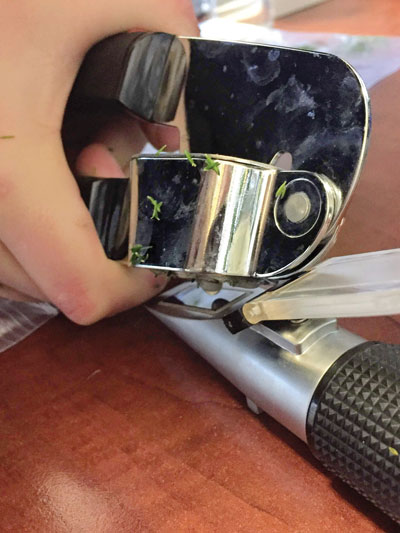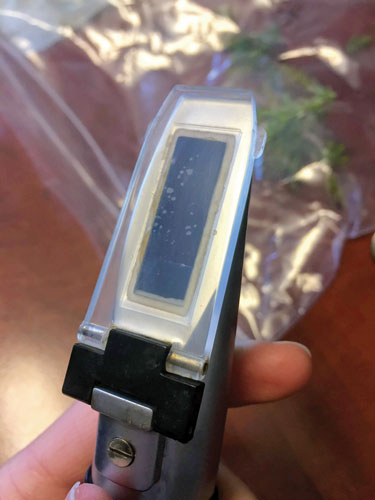2/1/2019
Sweet Science
Sylvia Schaap

The year I took the mandatory Food and Nutrition course in university marked the 100th year of ice cream research at the University of Guelph. We were a lucky year. Our prof was the present ice cream specialist. Instead of discussing the benefits of dietary fiber, all 200 of us ate ice cream he’d made and listened to the history and science of ice cream making.
I love ice cream. I will stand in line for it at an outdoor Dairy Queen when it’s -14C. I found out, though, that there’s more to the creamy deliciousness than meets the tongue. The one ice cream science fact that stuck with me was why it’s such a sweet, coooolllld treat: freezing point depression.
Pictured: Using a garlic press to squeeze out plant sap.
Sugar is a key ingredient because it lowers the chemical potential—and therefore the freezing point—so that it can be frozen and colder than 0C without being a hard block of unscoopable, cream-colored ice.
Why do you care? (Besides the fact that ice cream is delicious …)
Freezing point depression is one of the benefits of optimal photosynthesis, and therefore, healthy plants.
Wait, what?
The main product of photosynthesis is sugar. A healthy plant will do a lot of photosynthesis, and therefore, will have a high sugar content. This lowers the freezing point of the plant, which translates to reduced frost damage risk.
But knowing that fact is only helpful if you can use it somehow. That’s where the Brix meter comes in.
Sugar rush
Horticulturalists have been using the Brix meter for years, especially in the wine grape industry. Near harvest, the meter is constantly used to determine if the fruits are at the perfect sugar content to pick. Other fruit and vegetable growers have also started using them to measure produce quality. Forage growers might use it to tell when they should let their dairy cows into that particular pasture.
We ornamental growers have been a little slow on the uptake.
While your plants might look healthy, just using the subjective POV supplied by your eyes is sometimes not enough to determine if the plants are just barely photosynthesizing or are thriving. Brix puts a number on how sweet your plant is feeling. With ornamentals, if you’re seeing an issue, chances are your customer will, too. Brix is an early warning system before issues become visually apparent.
The Brix meter is a simple tool that uses light to measure the amount of dissolved solids like sugars, minerals and other nutrients in the solution. The more solids in the solution, the more the light refracts when passing through it. The more the light bends, the higher the Brix value, which we can translate as the percent of sugars and dissolved solids in sap.
The meter is practical as all get out: squeeze some sap on the prism and look through the eyepiece. You’ll see a circle with a ruled line—percentage of Brix on the left and approximate percentage of alcohol on the right. Where the white turns to blue is your real-time value of how your crop is performing overall.
If the change from white to blue is gradual, it means the crops calcium levels are good. And since calcium is the “locomotive” of the plant nutrient train, it’s a good thing to keep an eye on. Brix can be a good way to measure if your crop is struggling and gives you an opportunity to do something about it before major problems show up.
 How knowing Brix helps
How knowing Brix helps
Some claim that the higher the Brix, the lower the insect and disease pressure will be; this has neither been proven nor disproven by conclusive studies. Rather than try to correlate Brix values with insect and disease incidence, remember what William Albrecht said: “Insects and disease are the symptoms of a failing crop, not the cause of it. It’s not the overpowering invader we must fear, but the weakened condition of the victim.”
Brix is best seen as a measurement of plant health and photosynthetic ability … basically, the condition of the plant.
Pictured: Sap on the prism spread out by the cover.
Currently, we use the Brix meter to measure the “condition” of our stock plants. This way, we know if we need to make any changes or apply anything before taking cuttings, or we know if we need to treat the cuttings special in propagation. The healthier the stock plant, the better the cuttings will perform.
Taking samples is very easy; the only requirement for repeat sampling is consistency. The time is important. Where the sugars are located within the plant depends on the time of day, plus it can depend on the weather. For example, Brix levels fluctuate throughout the day, and when the barometric pressure drops before a storm, some plants send a large part of their sugars down to the roots so that if leaves are shredded, all the photosynthetic products aren’t lost.
Some crops are very easy to extract sap from. We happen to grow a lot of crops that aren’t so willing to give up their sap, like lavender and conifers, so we put labelled, dated sample bags in the freezer for a few hours or overnight. Once thawed, the plant parts are easier to squeeze juice out of for fresh samples. To squeeze sap out with less of a struggle, we use a simple garlic press.
The results can be recorded and tracked throughout the season. Optimal Brix varies for each crop and charts are available online listing target Brix levels for many different species. On average, a Brix value above 12 seems to be excellent and anything below 7 is poor.
Raising Brix levels in the plant comes down to optimizing photosynthesis and plant health. If Brix is low, double-check your nutrition program to make sure all macro- and micro-nutrients are adequately supplied and in balance. Applying calcium, boron and other micronutrient foliar sprays, or amino acid products to optimize protein production or seaweed extracts, which chelate micronutrients and supply natural plant growth hormones, can also help.
Every two weeks, the Qualitree growers bring in bags of samples and our after-school assistant takes and records the Brix levels. These numbers are then reviewed, and if there are low values, a foliar feed spray plan is created. We’ve been able to raise Brix in some plants after just one application.
Brix is a great, cheap way to put a value on how well your crop is performing at the spur of the moment, but it’s only one number. In order to fully understand what’s going on, consider sending away samples for detailed plant sap analysis.
Optimal photosynthesis means sweeter grapes, higher-quality fruits, vigorous plants and, most importantly for us pretty plant nerds, gorgeous flowers and vibrant foliage. By measuring Brix, you gain a pretty good idea of how happy your plant is and can manage accordingly. Hopefully, this means going from okay-looking plants to great-looking, great-performing plants.
While you decide whether starting off this article with an ice cream fact was relevant or not, I’ll eat vanilla ice cream and think about how plants make the sugar, feed the dairy cows and make the vanilla. GT
Sylvia Schaap works in IPM at Qualitree Propagators in British Columbia, Canada, spending free time hiking, hunting, writing and drawing in the mountains she now calls home.